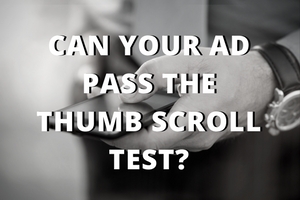The thumb scroll. You know what I’m talking about – the constant vertical swish used to feed new content to your smart device. Or the one finger roulette swipe that spins dozens of posts across your screen in the hopes that something catches your eye so you can stop – devour and scroll again.
So, how are you presenting your social content so your marketing engagement can pass the thumb scroll test? If you’re thinking video, you’re on the right track. People pay more attention to movement and motion and understand and accept information quicker through moving imagery.
Social video is designed to be viewed and shared on social media and is distinctly different from traditional TV commercials. Great social videos are created knowing that to increase engagement and make a deeper emotional connection – businesses must break through the noise and compete for a viewer’s attention. Here are seven tips to help you do just that.
1. Hook them fast!
The quicker your video ad delivers your message and captures attention, the better chance your target audience will remember what they see. Begin with your most engaging content and attention grabbing thumbnails and incorporate your brand identity early. By optimizing your video lead in with brand and messaging in the first 10 seconds, you can effectively reach 3x more people.
Fact: Facebook and Nielsen shows that 47% of the value of a video campaign comes from the first three seconds of video, and 74% from the first 10 seconds.
2. Keep it short.
40% of your audience will watch a video to the end of a 1 to 16-second-long Facebook video. That number drops to 18% when the video length increases to over 30 seconds. If it’s a match for your content, master the 15 second (link stilly valley ad) video format.
Remember – it only takes 3 seconds in Facebook video for metrics to count as a play. Create a more engaging video to get audiences to watch past the 3 second mark for greater message absorption.
3. Make it memorable and shareable.
Another way to stop the scroll is to create storytelling through captivating content and images your followers care about. Social videos that entertain with humor, emotional or inspirational messages or mobilize social causes are more effective at disrupting clutter to deliver messages that your audience will actually view and remember.
4. Design for AutoPlay with the sound-off.
As a marketer, having your social video play without a click helps engage a viewer, but users don’t appreciate being surprised by audio content that begins playing without their consent. Over 80% of viewers using social media choose to watch videos with the sound muted mainly due to their environment. Create video that works without audio and make sure you incorporate subtitles and visual elements that complement the video.
Fact: Video is winning in the Facebook news feed. Facebook video reaches 22% of fans, while an embedded YouTube reaches only 13%. AutoPlay is only available for native (uploaded at the site – not linked) video on Facebook and Twitter, so there is no click to engage, as there would be with embedded video for YouTube or Vimeo.
5. Caption your video.
Captioning your video helps boosts SEO. Search engines cannot watch a video or listen to audio, but they do index text. Caption your videos to rank higher in searches resulting in more views and more exposure. Also, colorful captions that catch the eye serve as an additional hook to draw your audience in and encourage them to watch for longer.
6. Optimize ads for screen alignment.
Mobile screens are small and are in portrait mode 98% of the time, and their screen aspect rations are often different. According to Animoto, square video outperformed landscape video on each social media network in terms of video views, engagement and completion rate.
7. Don’t Forget the Call to Action.
All that time and money spent making an effective social video shouldn’t be wasted by forgetting to inform your viewer of their next steps. Don’t let your video lead to a dead end with no clear path to additional information. Make sure you include a call-to-action that’s appropriate such as lead back to your website, a compelling offer or a link to engage your new follower on Twitter.
Facebook video posts have increased by 94% annually in the US from January 2014 to January 2015, clearly demonstrating the popularity of video content. As businesses continue to increase their use of social videos to meet their marketing objectives, sell a product and/or build brand awareness it is imperative for them to create compelling social videos that make a deep emotional connection that will disrupt the feed and stop the thumb-scroll.

